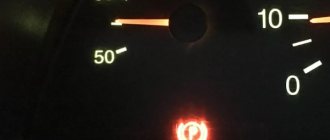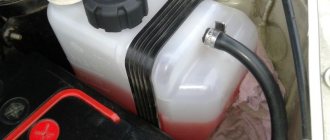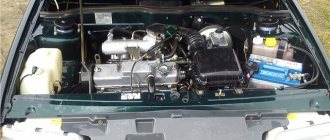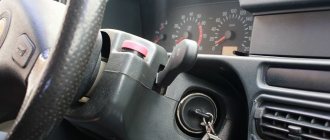The bane of every driver is the check engine warning light. Who has never peered with bated breath at this dashboard light when starting the car (will it go out or continue to burn)? Who has managed to avoid encountering such an “alarm signal” even once during the entire operation of the car? Almost no one. This is because there are a lot of reasons for the ECU, or more precisely the ECM (electronic engine control system), to be “concerned” about the serviceability of the power plant and related components. Both serious and trivial. Let us immediately make a reservation that there are additional factors of urgency in solving a potential problem, such as:
- combination with other warnings;
- indicator flashing;
- (relevant on some cars in cases where further driving may be dangerous) the check engine light turns red;
- The general “behavior” of transport is cause for concern.
The range of possible errors is truly enormous, so let’s look at the most common ones. So, the check engine light comes on, what should you do?
Reasons why the check engine light is on
Let's not go far and turn to the simplest and easily removable defects. A typical situation - you refueled at a gas station, turned the ignition key, drove off... and a characteristic icon “shines” on the dashboard. If the car does not make noise or jerk, you should return to the gas station to check the following points:
- the fuel tank cap is open/the system is not sealed;
- drop in oil level (check the quantity and quality with a dipstick, and also look for leaks);
- the fuel pump is acting up;
- the injectors are clogged;
- ignition coils are damaged;
- spark plugs are sooted or out of order;
- the cylinder does not produce a spark;
- problems with the oxygen sensor (lambda probe);
- the catalyst is broken;
- low quality fuel.
If the check engine light is on, make an appointment for an internal combustion engine diagnostic.
Lambda probe
It is mistakenly called an oxygen sensor, although it has nothing to do with oxygen. The lambda probe is designed to capture unburned fuel residues that are formed when the ignition timing is incorrect. Thanks to the data received from the sensor, the angle is adjusted, as well as the saturation of the mixture with gasoline.
In the absence of information caused by a malfunction of the lambda probe, ECU, or, as it is also called, the controller switches the power plant to emergency operation. In this mode, the mixture is supplied as if it were a carburetor - in strictly specified proportions in order to maintain engine performance until it arrives at the service center. Accordingly, a check light lights up on the instrument panel, which indicates a malfunction.
The main signs of sensor failure are:
- Increased fuel consumption;
- “Floating” speed;
- Increased harmful emissions from the exhaust pipe;
Check engine light is yellow
On most cars, such as VAZ, Gazelle or Mazda, the color of this indicator will be yellow or reddish. Moreover, in the absence of other signs, this may mean either a serious malfunction or an error on the on-board computer (when, over a long service life, information about minor errors that has not been reset has accumulated in the memory). In this case, a short-term reset of the negative terminal of the battery (for 15-20 seconds) is a suitable solution - this will give the system a shake-up necessary in case of a simple “glitch”. There are several other methods of possible “self-medication”. If it doesn't help, the reason is deeper.
When the check engine light is on, try:
- check the tank lid (if it is open, close it);
- unscrew the spark plugs and check their condition;
- inspect the wires for external damage;
- conduct computer diagnostics for faulty sensors.
Resetting or zeroing the Check indicator
In most cases, as the table shows, Check lights up when a sensor fails or the operating conditions of the vehicle change.
However, even after diagnosing and eliminating the malfunction, the light sometimes continues to light. The fact is that the “trace” of the error remains in the computer’s memory. In this case, you should “reset” or “zero” the indicator readings. You can easily do this yourself by performing a number of simple operations:
- Turn off the ignition.
- Open the hood.
- Disconnect the positive terminal from the battery.
Resetting or resetting the Check Engine Light
The sensor is reset and the Check light is no longer on. If this does not happen, contact the service center.
When the Check Engine light comes on on the dashboard, you almost always need to stop the car immediately. Using the recommendations given in this article in practice will help you avoid complex, expensive engine repairs. Good luck on the roads!
Yes, maybe the spark plugs are crap... I bought NGK at the end of summer, changed it, vibration then appeared, the speed sometimes fluctuated, I recently bought new ones, but this time from GM, they have the same NGK of the same marking, installed it, no problems at all. It just happened, it happens.
What is Check Engine?
Check Engine (translated as Check Engine) is an indicator located on the dashboard, well known to all owners of modern cars.
This light comes on when any problem occurs in the car's engine. In this case, car manufacturers recommend urgently contacting a service station (service station). At the service station, a special device is connected to the vehicle's diagnostic connector - a scanner, which is used to read the fault code (error code) registered by the vehicle's self-diagnosis system, indicating the cause of the malfunction.
The need for urgent treatment is due to the fact that further operation of a car with a malfunction can lead to serious engine damage and large financial costs for its owner. For example, misfire of the mixture in any of the engine cylinders, resulting from a faulty spark plug or ignition wire (type P03xx fault codes) can lead to rapid failure of the exhaust gas catalytic converter. For reference: the cost of a catalyst for a VAZ
If the meat grinder is on fire, it means there is some error in the ECU memory. Why guess - when you can stupidly scan the code on any diagnostic? +a lot. Spend a little time and stop by for diagnostics. It definitely won't get any worse. Otherwise, you can change everything and maybe you will find the reason.
find out the reason, the sooner the better so as not to kill the engine's luck
Check engine light is red
Perhaps, it doesn’t matter if the check engine lights up yellow or red, the question of whether it’s possible to drive with it worries all car owners who have encountered this. But on some machines, in addition to general additional signs (several lights are on at once, the engine is throttling, the speed drops, fuel consumption increases, etc.), the color of the indicator changes to demonstrate the urgency of the problem. Usually, when the check light is on and the engine is running normally and other indicators are normal, they focus on the blinking indicator. We offer a schematic diagram for a better understanding of your transport.
There can be many situations and explanations why the check engine light is on in a car. For example, after high-pressure washing, if the system is initially “fragile” and there is a high risk of its depressurization, moisture can get onto the chafed contacts or into the insides through holes made by corrosion. Diagnostic procedures here should begin with thorough drying of the engine compartment; a special lubricant to displace moisture will not hurt. Or, as previously mentioned, bad gasoline with low quality additives could disrupt the operation of the fuel system. It is not uncommon for the check light to come on after replacing the engine. Here, the “culprit” may be incorrect installation or low quality of the spare part, especially if it is a contract one.
Meaning and decoding of codes
During self-diagnosis of a VAZ 2115 with an injector, only numbers or flashes that code the error will be shown on the instrument panel. When reading trouble codes from an electromechanical instrument cluster, it is necessary to record the number of flashes and calculate error numbers from them. Their purposes can be deciphered using a special list. Most of these faults can be resolved independently by replacing failed sensors.
Self-diagnosis codes
When performing diagnostics, it is necessary to take into account that the number on the screen may indicate two summed errors. For example, 9 indicates the presence of two faults - numbered 1 and 8.
| Numeric combination | Decoding |
| 1 | ECU problem |
| 2 | Incorrect data from the fuel level sensor |
| 4 or 8 | Network power problems |
| 12 | Malfunction of the error lamp circuit in the instrument cluster |
| 13 | No signal from lambda probe |
| 14 or 15 | Incorrect data from temperature sensor |
| 16 or 17 | Problems with the network power supply, it is necessary to check for short circuits |
| 19 | Motor shaft position sensor error |
| 21 or 22 | Throttle sensor error |
| 23 or 25 | Incorrect operation of the intake air temperature sensor |
| 24 | Speed sensor faulty |
| 27 or 28 | No signal from lambda probe |
| 33 or 34 | No air flow data available |
| 35 | Idle speed control sensor is faulty |
| 42 | Ignition control circuit problem |
| 43 | Knock sensor failure |
| 44 or 45 | Violation of the composition of the mixture |
| 51 or 52 | ECU memory errors |
| 53 | Error in CO setting sensor (installed on cars without converter) |
| 54 | Octane corrector sensor (installed on cars without a converter) |
| 55 | Violation of the composition of the mixture |
| 61 | Failure of the lambda probe |
What to do if the check engine light is on
The obvious recommendation is to contact a car service for professional help and competent diagnostics. Of course, if you understand the structure of your car and can figure out the “illness” on your own, then take the flag. Moreover, today there are a huge number of forums on the Internet that unite car owners of various brands, where they separately discuss the reasons for a check engine on a VAZ 2115 or a check engine on a running Gazel engine. Such clarifications will help narrow the scope of troubleshooting by establishing the characteristic features of the transport of a particular assembly. Moreover, it is possible to download special software onto a personal computer or smartphone to accurately decipher a specific error code.
However, most often, no matter what the reasons why the check engine light is on (provided they are of the slightest seriousness), replacement will be needed. This is true for:
- catalyst;
- candles;
- high-voltage wires;
- fuel pump relay (fault detected);
- adsorber (unit that absorbs gasoline vapors), if installed;
- idle speed controller;
- mass air flow sensor, etc.
Thus, whether the Gazel “check engine” light is on or the VAZ 2115 “check engine light” is on, the help of a technician will not be superfluous. And so as not to mistakenly purchase unnecessary replacement components, a certified power plant diagnostician will help you get to the bottom of it.
Mass fuel flow sensor
Mass air flow sensor is a very important element of any injection engine. It is a plastic structure with a platinum thread inside. When the ignition is turned on, a small voltage is applied to it, which increases the temperature due to the high resistance. When the engine starts, the incoming air cools it, which causes the resistance to change, and according to Ohm's law, this affects the voltage. All this data is collected by the controller and processed, making a conclusion about how much air passes through the mass air flow sensor.
If the sensor malfunctions, important readings stop coming or are given in an incorrect form, which is why the engine control unit switches it to emergency mode. In addition, there are a number of signs that indicate a malfunction:
- Poor dynamics;
- Long engine start;
- Increased fuel consumption;
- Unstable or “floating” speed;
Communication with cars
As with most problems with personal transport, you need to be able to listen to it. Modern vehicles are equipped with “brains” and interactive dashboards to “talk” to you, but it’s also wise to pay attention to the “classical language”: knocks, vibrations, hums, loss of power and much more. We looked at the most “popular” answers to the question why the check engine light is on. We hope this helps.
Sources
- zen.yandex.ru/media/uremont/gorit-chek-dvigatelia-check-engine-prichiny-i-resheniia-problemy-5dc55df686c4a9c8460bf611
- ladaautos.ru/vaz-2115/chto-delat-esli-gorit-chek-vaz-2115-inzhektor.html
Why is a warning system needed?
Why the Lada Granta check engine light is on and what to do
A panel that flashes periodically or is constantly on, which depicts an engine outline, or has the inscription “Check Engine” can be translated as “check the engine.” Its appearance warns the driver about emerging problems in the power unit. Most of all, its appearance worries novice drivers, but there is no need to be afraid, you just need to diagnose the engine and then eliminate the identified faults. The first such blocks were connected to an on-board computer; its main purpose was to control the carburetor of the power unit.
Cars are constantly improving, and so are electronic control units. Now they control other systems, such as ignition, supply, formation of a combustible mixture, engine speed, and other parameters. As a result of this modernization, the reasons for the control unit to react have become many times greater, so it has become much more difficult to understand the reasons for the appearance of warning signals, and sometimes it is completely impossible to do without special equipment
Why does the VAZ 2114 cylinder not work?
In order to make sure exactly why the cylinder failed, it is necessary to check all the elements that could cause the cylinder to fail.
Always start with the spark plugs
Checking the spark plugs
Checking the performance of the spark plug must be done on a special stand or by unscrewing the spark plug and putting it on its cap and placing it on the valve cover. Then ask someone you know or passerby to turn the starter. A spark should appear on the spark plug periodically. If it is missing, then the reason is in the candle.
It is better to check the spark plug on a cylinder that was initially in working condition.
Checking wires
High-voltage wires are made of special material with high insulation resistance to ensure reliable transmission of high voltage to the spark plug.
It is necessary to inspect the wires for breaks or damage to the insulation. The wire cap must be securely fixed to the spark plug and press the contact tightly against it.
If the wires have a characteristic worn appearance, they must be replaced.
Ignition module
The ignition module on the VAZ 2114 has two coils inside, each of which regulates the voltage supply to two cylinders. For example, the first coil is responsible for the operation of 1-4 cylinders, and the second is responsible for the operation of 2-3 cylinders.
From this we can conclude that if two cylinders, namely 1-4 or 2-3, do not work at once, then most likely there is a breakdown in the ignition module.
You can accurately verify this by removing this part from another car and installing it on a faulty car for testing.
Clogged fuel injectors
The injectors spray fuel into the combustion chamber. The VAZ 2114 has one injector for each cylinder. If one of the injectors becomes clogged, then the operation of this cylinder becomes impossible due to the lack of fuel mixture in it.
Checking the injectors can be done by measuring the fuel pressure and opening one of the injectors. The best way is to remove the fuel rail and wash the injectors.
Valves problem
Burnout of valves significantly affects the operation of the entire internal combustion engine. It occurs due to incorrect valve adjustment, namely when the valve is pressed and constantly open.
Also, if the valves are not adjusted correctly, engine tripping may occur.
You can check this by measuring the compression. To do this, instead of a spark plug, we screw in a compression gauge (a device for measuring compression in the engine) and the starter turns several revolutions. If there is no compression or it is much lower, then most likely the valve in the internal combustion engine is burnt out or incorrectly adjusted, or the CPG is worn out. To prevent wear on the CPG, it is necessary to drop some engine oil into the engine and measure again. Engine oil helps increase compression when the piston and rings wear. If there is no compression upon repeated measurement, then there is a problem with the valve.
DPKV failure
The sensor that takes readings from the rotation of the crankshaft is called DPKV. It determines the position of the piston in the engine and sends signals to the ECU. The sensor is directly involved in spark formation. If it fails, there will be no spark on all four cylinders and the engine will not be able to start.
Breakdown in the ECU
The control unit contains an electrical board with a large number of radio elements. Each element is responsible for a specific sensor. Special keys are responsible for the operation of the ignition module, which quite often fail, which makes it impossible to supply a spark to a certain cylinder.
If the engine in your car is not working, and you have tried all the methods, then it is best to contact an experienced electrician who can diagnose a breakdown in the engine control unit.











